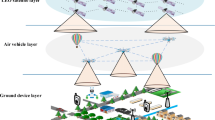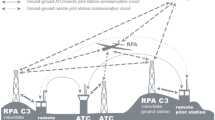Abstract
Modern solutions based on Artificial Intelligence (AI) play an important role in the management of drone’s resources in Space-Air-Ground-Integrated-Network (SAGIN). AI can use information collected by drone sensors to develop routing protocols, optimize communication networks, improve energy efficiency, and predict user behavior. In this regard, the analysis of data loss in SAGIN with AI is relevant. This work is devoted to the calculation of packet losses in SAGIN, containing additional hardware of AI system. Based on the original model containing a Base Station (BS), a stratospheric Remotely Piloted Air System (RPAS) with an AI system, a low-orbit satellite, a low-altitude RPAS and a user of a terrestrial cellular network, data traffic was simulated using NetCracker Professional 4.1 software. The AI system was simulated by a cloud structure with the ability to change the delay and the probability of packet losses. Quantitative characteristics of traffic in SAGIN channels with such a model of the AI hardware system are obtained. The dependences of packets losses on the size of messages and the data transfer rate are calculated. The dependences of BS uplink Average Load and the packets travel time on the TS, as well as the dependences of the Bit Error Rate (BER) on the Average Load, are obtained. The results are valuable in terms of practical guidelines for choosing data transfer modes and the necessary hardware parameters for an AI system.








Similar content being viewed by others
Data Availability
All data generated and analyzed during this study are included in this article. The datasets generated during the current study are available from the corresponding author on request.
References
A. Carrio, C. Sampedro, A. Rodriguez-Ramos and P. Campoy, A Review of deep learning methods and applications for unmanned aerial vehicles, Journal of Sensors, 2017. https://doi.org/10.1155/2017/3296874.
P. S. Bithas, E. T. Michailidis, N. Nomikos, D. Vouyioukas and A. G. Kanatas, A survey on machine-learning techniques for UAV-based communications, Sensors, Vol. 19, No. 23, pp. 5170, 2019. https://doi.org/10.3390/s19235170.
M. Chen, U. Challita, W. Saad, C. Yin and M. Debbah, Artificial neural networks-based machine learning for wireless networks: a tutorial, IEEE Communications Surveys & Tutorials, Vol. 21, No. 4, pp. 3039–3071, 2019. https://doi.org/10.1109/COMST.2019.2926625.
P. V. Klaine, R. D. Souza, L. Zhang, and M. Imran (2020) “An Overview of Machine Learning Applied in Wireless UAV Networks,” Wiley 5G Ref, 1–15. https://doi.org/10.1002/9781119471509.w5GRef231.
M.-A. Lahmeri, M. A. Kishk and M.-S. Alouini, Artificial intelligence for UAV-enabled wireless networks: a survey, IEEE Open Journal of the Communications Society, Vol. 2, pp. 1015–1040, 2021. https://doi.org/10.1109/ojcoms.2021.3075201.
Computational Intelligence for Unmanned Aerial Vehicles Communication Networks. (Springer, 2022), 289 p. https://doi.org/10.1007/978-3-030-97113-7.
M. Mozaffari, W. Saad, M. Bennis, Y.-H. Nam and M. Debbah, A tutorial on UAVs for wireless networks: applications, challenges, and open problems, IEEE Communications Surveys & Tutorials, Vol. 21, No. 3, pp. 2334–2360, 2019. https://doi.org/10.1109/comst.2019.2902862.
J. Liu, Y. Shi, Z. Md Fadlullah and N. Kato, Space-air-ground integrated network: a survey, IEEE Communications Surveys & Tutorials., 2018. https://doi.org/10.1109/comst.2018.2841996.
N. C. Luong, D. T. Hoang, S. Gong, D. Niyato, P. Wang, Y.-C. Liang and D. I. Kim, Applications of deep reinforcement learning in communications and networking: a survey, IEEE Communications Surveys & Tutorials., 2019. https://doi.org/10.1109/comst.2019.2916583.
P. Chowdhury, M. Atiquzzaman and W. Ivancic, Handover schemes in satellite networks: state-of-the-art and future research directions, IEEE Communications Surveys & Tutorials., Vol. 8, No. 4, pp. 2–14, 2006. https://doi.org/10.1109/comst.2006.283818.
R. Radhakrishnan, W. W. Edmonson, F. Afghah, R. M. Rodriguez-Osorio, F. Pinto and S. C. Burleigh, Survey of inter-satellite communication for small satellite systems: physical layer to network layer view, IEEE Communications Surveys & Tutorials., Vol. 18, No. 4, pp. 2442–2473, 2016. https://doi.org/10.1109/comst.2016.2564990.
L. Gupta, R. Jain and G. Vaszkun, Survey of important issues in UAV communication networks, IEEE Communications Surveys & Tutorials., Vol. 18, No. 2, pp. 1123–1152, 2016. https://doi.org/10.1109/comst.2015.2495297.
S. Hayat, E. Yanmaz and R. Muzaffar, Survey on unmanned aerial vehicle networks for civil applications: a communications viewpoint, IEEE Communications Surveys & Tutorials, Vol. 18, No. 4, pp. 2624–2661, 2016. https://doi.org/10.1109/comst.2016.2560343.
C. Niephaus, M. Kretschmer and G. Ghinea, QoS provisioning in converged satellite and terrestrial networks: a survey of the state-of-the-art, IEEE Communications Surveys & Tutorials., Vol. 18, No. 4, pp. 2415–2441, 2016. https://doi.org/10.1109/comst.2016.2561078.
A. Alimi, A. O. Mufutau, A. L. Teixeira and P. P. Monteiro, Performance Analysis of Space-Air-Ground Integrated Network (SAGIN) over an arbitrarily correlated multivariate FSO channel, Wireless Personal Communications., Vol. 100, No. 1, pp. 47–66, 2018. https://doi.org/10.1007/s11277-018-5620-x.
Y. Shi, J. Liu, Z. M. Fadlullah and N. Kato, Cross-layer data delivery in satellite-aerial-terrestrial communication, IEEE Wireless Communications., Vol. 25, No. 3, pp. 138–143, 2018. https://doi.org/10.1109/mwc.2018.1700354.
Y. Shi, Y. Cao, J. Liu and N. Kato, A cross-domain SDN Architecture for multi-layered space-terrestrial integrated networks, IEEE Network., Vol. 33, No. 1, pp. 29–35, 2019. https://doi.org/10.1109/mnet.2018.1800191.
Z. Zhou, J. Feng, C. Zhang, Z. Chang, Y. Zhang and K. M. S. Huq, SAGECELL: software-defined space-air-ground integrated moving cells, IEEE Communications Magazine., Vol. 56, No. 8, pp. 92–99, 2018. https://doi.org/10.1109/mcom.2018.1701008.
C. Yan, L. Fu, J. Zhang and J. Wang, A comprehensive survey on UAV communication channel modeling, IEEE Access., Vol. 7, pp. 107769–107792, 2019. https://doi.org/10.1109/access.2019.2933173.
ZMd. Kato, F. Fadlullah, B. Tang, S. Mao, A. Okamura. Tani and J. Liu, Optimizing space-air-ground integrated networks by artificial intelligence, IEEE Wireless Communications, 2019. https://doi.org/10.1109/mwc.2018.1800365.
Z. Li, Y. Wang, M. Liu, R. Sun, Y. Chen, J. Yuan and J. Li, Energy efficient resource allocation for UAV-assisted space-air-ground internet of remote things networks, IEEE Access., Vol. 7, pp. 145348–145362, 2019. https://doi.org/10.1109/access.2019.2945478.
N. Cheng, F. Lyu, W. Quan, C. Zhou, H. Hei, W. Shi and X. Shen, Space/aerial-assisted computing offloading for IoT applications: a learning-based approach, IEEE Journal on Selected Areas in Communications., 2019. https://doi.org/10.1109/jsac.2019.2906789.
R. Shafin, L. Liu, V. Chandrasekhar, H. Chen, J. Reed and J. C. Zhang, Artificial intelligence-enabled cellular networks: a critical path to beyond-5G and 6G, IEEE Wireless Communications., 2020. https://doi.org/10.1109/mwc.001.1900323.
H. Yin, P. Liu, K. Liu, L. Cao, L. Zhang, Y. Gao and X. Hei, X., “ns3-ai”. Proceedings of the 2020 Workshop on ns-3. (2020). https://doi.org/10.1145/3389400.3389404
G. Luo, Q. Yuan, J. Li, S. Wang and F. Yang, “Artificial Intelligence Powered Mobile Networks: From Cognition to Decision”. arXiv:2112.04263. (2021)
D. Liu, J. Zhang, J. Cui, S.-X. Ng, R. G. Maunder and L. Hanzo, Deep learning aided packet routing in aeronautical Ad-Hoc networks relying on real flight data: from single-objective to near-pareto multi-objective optimization, IEEE Internet Things J. Early Access, 2021. https://doi.org/10.1109/JIOT.2021.3105357.
A. Grekhov, V. Kondratiuk and S. Ilnytska, Data traffic modeling in RPAS/UAV networks with different architectures, Modelling., Vol. 2, pp. 210–223, 2021. https://doi.org/10.3390/modelling2020011.
Funding
The authors declare that no funds, grants, or other support were received during the preparation of this manuscript.
Author information
Authors and Affiliations
Contributions
AG and VK: Conceptualization, AG: methodology, AG, VK. and VK: validation, AG: investigation, VK. and VK: resources, AG: writing—original draft preparation, VK: writing—review and editing, VK: supervision, VK: project administration, All authors have read and agreed to the published version of the manuscript.
Corresponding author
Ethics declarations
Conflicts of interest
The authors have no relevant financial or non-financial interests to disclose.
Additional information
Publisher's Note
Springer Nature remains neutral with regard to jurisdictional claims in published maps and institutional affiliations.
Rights and permissions
Springer Nature or its licensor (e.g. a society or other partner) holds exclusive rights to this article under a publishing agreement with the author(s) or other rightsholder(s); author self-archiving of the accepted manuscript version of this article is solely governed by the terms of such publishing agreement and applicable law.
About this article
Cite this article
Kharchenko, V., Grekhov, A. & Kondratiuk, V. Packet Losses in SAGIN with Artificial Intelligence. Int J Wireless Inf Networks 30, 164–172 (2023). https://doi.org/10.1007/s10776-022-00579-2
Received:
Revised:
Accepted:
Published:
Issue Date:
DOI: https://doi.org/10.1007/s10776-022-00579-2




